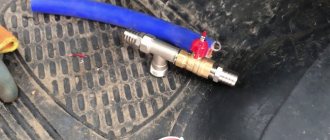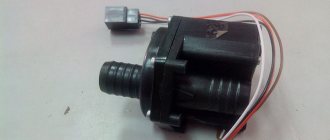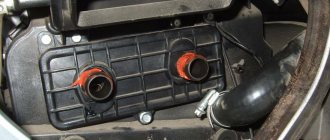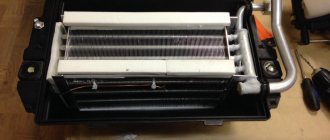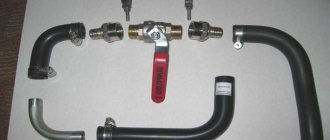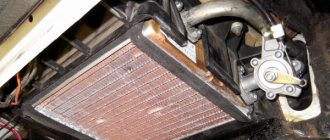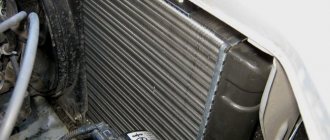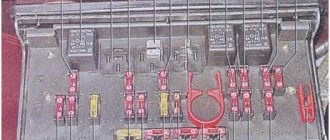What is an electric heater valve?
Electric heater valve (heater control valve with electric drive, heater valve) is a component of the vehicle interior/cabin heating system; a tap or valve to control the supply of coolant from the engine cooling system to the heater radiator (heat exchanger).
An electrically operated faucet is similar to a mechanical faucet, but is driven by a built-in electric motor or solenoid. This solution made it possible to abandon the cable drive and implement control of the heater using a button. Electric cranes make it possible to implement various schemes for heating the interior and operating the engine cooling system, while they are easy to use, reliable in operation and have a simple design.
Heater Gazelle business principle of operation.
The Gazelle Business heater is not a bad parody of foreign car heaters, but only at first glance. The heater is controlled by buttons and knobs on the electronic unit located on the control panel. The air in the heater, as on all Gazelles, is sucked in by an electric fan through the grilles under the windshield and, passing through air ducts and deflectors, enters the cabin. Coolant is supplied to the heater radiator through a tap, the opening and closing of which is carried out by an electric drive. It is distinguished from the same taps of previous models by the presence of an additional fitting. When the valve is closed, the liquid is redirected back to the cooling system.
Types, design and operating principle of electric heater valve
Electrically controlled faucets existing today are divided into groups according to the type of shut-off element and its drive, and according to the number of circuits (and, accordingly, pipes).
Based on the number of circuits and pipes, heater valves are:
- Single-circuit / 2-pipe - ordinary taps / valves;
- Double-circuit / 3-pipe - three-way valves.
Double-port valves are valves that can only open and close the flow of liquid. In such a faucet, one pipe is inlet, the second is outlet, and between them there is a shut-off element. The dual-port heater valve is used in conventional interior heating systems and is located between the engine cooling system outlet and the heater core inlet to control the flow of hot coolant.
Three-way valves are three-way valves that can direct fluid flow into two different pipelines. This faucet has one inlet and two outlets, and the shut-off element is designed in such a way that it can direct liquid from the inlet to one of the outlets while simultaneously blocking the other. A heater valve with three pipes can be used in various interior heating systems: with bypass, with an additional heater, etc.
According to the type of shut-off element and its drive, taps are:
- Gate valves driven by an electric motor;
- Shut-off valves driven by a solenoid.
The design of gate valves is simple. They are based on a plastic molded body with pipes, inside of which there is a rotating plate in the form of a solid sector or a sector with holes the size of the pipes. A compact electric motor with a simple gear reducer is installed on the housing, with the help of which the plate rotates. In faucets with two nozzles (double-circuit), both nozzles are located opposite each other, with a plate between them. Three-way faucets have an inlet on one side and two outlets on the other.
The heater valve with an electric motor works as follows. When the heater is turned off, the valve plate is located between the pipes, blocking the flow of liquid - in this case, hot liquid does not flow into the heater radiator, and the interior heating system does not work. If it is necessary to turn on the stove, the driver presses a button on the dashboard, current is supplied to the electric motor of the faucet, it turns the plate and opens the path of coolant - the heater radiator heats up, the interior heating system begins to work. To turn off the heater, the driver presses the button again, all processes occur in reverse order, and the heater turns off.
A heater tap with three pipes also works easily if there is a bypass in the heating system. When the heater is turned off, the rotary plate is in such a position that the coolant passes through the tap and through the exhaust pipe enters the inlet of the engine cooling system (to the pump). When the heater is turned on, the plate rotates, closes one outlet pipe and opens the second - now the fluid flow freely passes into the heater radiator, and from it enters the exhaust pipe and the inlet of the engine cooling system. When the stove is turned off, all processes occur in reverse order.
The design of shut-off solenoid valves is different. They are based on a plastic case, inside of which there is a lifting valve in the form of a truncated cone. In the closed position, the valve sits on its seat, blocking the flow of liquid. The valve is connected via a rod to the solenoid armature, which is mounted on the valve body. Double-circuit valves can be single- or double-solenoid. In the first case, both locking elements are located on the solenoid rod, in the second, each locking element is controlled by its own solenoid.
The operation of the heater solenoid valve is also simple. The valves are normally open - without voltage on the solenoid, the valve is raised by a spring, the channel is open. When the engine starts, voltage is applied to the solenoid and the valve closes. When the stove is turned on, the solenoid is de-energized, the tap opens and supplies hot liquid to the heating radiator. When the stove is turned off, voltage is supplied to the solenoid again and the tap closes. A dual-circuit valve works in a similar way, however, one of its circuits is always closed when the ignition is turned on - this prevents the supply of coolant to the heater radiator; the liquid flows through the bypass. When the heater is turned on, the circuits switch, the coolant flows to the heater radiator, and when the heater is turned off, the valve returns to its original position. Both solenoids of a double-circuit valve never open or close at the same time (except during a complete blackout, when both valves are open).
Heater Gazelle business troubleshooting.
What to do if something in the heater does not work? Due to the design of the heater, diagnostics in case of failure of its parts is difficult. Initially, as always, you need to check the fuse.
Checking the heater tap.
When operating the Gazelle Business heater, a problem may arise in the supply of hot air when the ventilation is turned on, or, conversely, cold air when the heater is turned on. The reason is that the heater tap does not work. It does not open or shut off the coolant flow to the heater core. The design of the crane is quite simple and at the same time somewhat more complex than the similar crane installed on the Gazelle restyling. It's all about the built-in crane control unit,
To find the cause of a heater tap failure, you will need a piece of copper wire and a test lamp. No special knowledge or skills are needed to determine the malfunction.
First you need to check the presence of plus and minus on the connector connected to the tap. This is done with a test lamp by connecting its probes (wires) to the black and white wires of the connector. If the warning light does not light, then move the wire connected to the black wire to a metal part of the engine where there is a good minus. If the lamp lights up, repair the break in the black wire or clean its attachment to the body. If the lamp does not light up in this case, then you need to check fuse F13 and the serviceability of the wire from it to the connector.
If there is a plus and minus on the connector, use a small piece of copper wire to alternately connect the black wire with the brown and green wires. If the heater valve gearbox is in good working order, the characteristic sound of its operation will be heard. If nothing happens, the tap needs to be replaced.
Checking gearmotors.
Checking the gear motors of the windshield blower dampers and deflectors can be checked without completely removing the panels. It is enough to remove its lower part. The main damper motor is accessible from the driver's side. To check gearmotors, you need to disconnect the connector of its electric motor, the connector with a lock, and connect a tester to it in voltmeter mode or a test lamp. With the ignition and heater on, you must press the button that controls this damper. The control lamp should light up. If the lamp is on and the gearmotor does not work, it must be replaced.
If you are on the road and do not have the opportunity to replace the damper drive with window defroster, you can remove the rod from the damper lever on the driver’s side and turn it manually, locking it in the open position. To open the damper on the passenger side, you will need to unscrew the screws securing the gearmotor and, by turning its housing, secure it in the same way.
Checking the electric motor and speed controller.
To check the heater fan motor and the cause of its failure if the fan does not work, you will need to remove the air intake in the engine compartment. Inside the window that opens, two wires with a connector will be visible. To check the power supply, connect a test lamp to the connector terminals and, with the ignition on, turn the heater speed control toward maximum speed. The control lamp should light brightly. When turning the handle towards the minimum speed, the brightness of the lamp should decrease. This indicates that the speed controller is working properly.
If the control lamp is on and the fan does not rotate, then its electric motor is faulty. To check, measure the resistance between the motor terminals in the connector. Motor malfunction may be caused by stuck brushes. In this case, you can try knocking on the heater body. In this case, the operation of the fan can be restored before the next time it is turned off, possibly longer, but you can still get to the service center in a warm place.
Questions about choosing and replacing a heater tap
The heater valve is very important for the operation of the interior/cabin heating system, however, selecting and replacing this part in most cases does not cause any problems. To select the right faucet, you must follow several recommendations:
- The power supply voltage of the crane motor must correspond to the voltage of the vehicle’s on-board electrical network - 12 or 24 V;
- The type of tap - 2 or 3 pipes - must correspond to the interior heating system diagram. For conventional systems, a tap with two pipes is required; for systems with bypass, a tap with three pipes is required. Also, a tap with three pipes can be used to create a heating system with an additional heater;
- The diameter of the pipes must correspond to the diameter of the heating system pipelines, but if necessary, adapters can be used;
- The faucet and vehicle must have the same type of electrical connector. If necessary, it is necessary to replace the type of connector on the vehicle;
- The crane must have dimensions suitable for its installation.
The heater valve must be replaced after draining the coolant; metal clamps must be used for installation. It is necessary to ensure that the tap is installed correctly - position its inlet and outlet pipes in accordance with the direction of the liquid. For convenience, there are arrows on the nozzles indicating the direction of fluid flow. If you install a regular 2-pipe valve incorrectly, the system will work, but incorrectly installing a 3-pipe valve will make the system completely inoperable. If the faucet is installed correctly and reliably, the stove will start working immediately, providing warmth and comfort in the car interior.
The importance and benefits of the interior heating system are felt only in the cold season. When summer comes, the need to use the system disappears. But, as you know, you need to prepare a sleigh in the summer. In the summer, daylight hours are longer, and the weather is conducive to quick and high-quality repairs. First you need to understand how the heating system in a car is designed and functions. On a Gazelle Business car, as on all cars with a liquid-cooled engine, a stove is installed, into which heat is supplied from the heated parts of the engine through coolant. The liquid heats the heater radiator, the fan blows air, which, passing through the honeycombs, heats up and spreads throughout the cabin. Gazelle Business stoves are equipped with an electronic control unit that can control the heater both automatically and manually. To do this, it has a cabin temperature sensor that allows you to maintain the set temperature. All adjustments are electric, and not on cables, as in previous versions. The dampers are controlled by gearmotors, and the temperature is controlled by an electric valve (reducing or increasing the amount of coolant passing through the radiator). All controls are placed on the front panel, which is very convenient and does not distract the driver from driving the car. But any equipment sooner or later malfunctions.
How to choose an electric crane for a Gazelle
Replacing the heater tap on a Gazelle yourself requires you to first purchase a new device.
In the vast majority of cases, there are no problems with choosing a node. When selecting a device, you should follow a few simple rules:
- Supply voltage. Depending on the electric motor of the faucet, the corresponding voltage in the on-board network may be required from the on-board network. Accordingly, it is 12 or 24V.
- Faucet type. This refers to the number of pipes. There can be 2 or 3 of them. The choice directly depends on what heating system scheme is used on your Gazelle. If this is a conventional system, the 2-pipe option is required. Three-pipe ones are relevant for those schemes where a bypass is provided. Also, 3 pipes can be installed in situations where the Gazelle car owner wants to independently equip the car with an additional heater.
- The choice of pipe diameter depends on the diameter of the pipelines in the heating system. Although this is not necessary, since special adapters are available for sale.
- It is important to select a unit that matches the same type of electrical connector for both the tap and the machine. If the need arises, the connector on the machine can be changed.
- The tap must have suitable overall dimensions to fit in the location of the heater tap.
If we talk specifically about Gazelle, then electric cranes with 2 and 3 pipes can be used here. This directly depends on the car model, year of manufacture and engine used.
Two-pipe devices are used on the GAZ 3302 model line in the following modifications:
- engines with a volume of 2.3 and 2.5 liters, produced from 1994 to 2006;
- with engines of 2.4, 2.7 and 2.9 liters of the 1994-1996 model;
- with 2.5 and 2.7 Euro III engines, which have been produced since 2008;
- for 3302 with injection engines of 2.3, 2.5, 2.7 liters, including versions with power steering from 1997;
- for ICE 2.4 from Chrysler since 1999.
There are many more options for using 3-pipe models with electric cranes.
These are the following car versions:
- 3302 with 2.3 and 2.5 liter engines from 1994 to 2006;
- 3302 with 2.4, 2.7 and 2.9 liter engines from 1994 to 1999;
- 3302 with 2.5 and 2.7-liter Euro 3 internal combustion engines, produced since 2008;
- 3302 with Chrysler engine;
- 33025 with a 2.9 injector and a 2.8 liter diesel engine;
- 33025 with a 2.8-liter Cummins engine and a 2.9-liter Euro 4 engine;
- 33025 with a 2.9 liter injector;
- 33027 with 2.7 and 2.8 liter diesel engines;
- Gazelle Business with all internal combustion engines, including 2.9 liter injector, 2.4 liter Chrysler, 2.8 liter diesel engine, Cummins engines, etc.
The estimated cost of an electric crane from a good manufacturer will be from 1 thousand rubles. At the same time, traditionally three-pipe devices cost 200-300 rubles more than analogues with 2 pipes.
Diagnostics
If signs of malfunction or malfunction are detected, it is necessary to carry out diagnostics to identify the causes of the breakdown. One of the reasons why the heater begins to heat worse, or when very cold air comes out of it, is the valve of the Gazelle stove. It either does not open completely or is completely closed. If any of these signs occur, you must first check the correct operation of the electric crane.
- With the engine warm, touch the pipes before and after the electric valve. In the extreme hot position of the temperature adjustment handle, the pipe before and after the electric tap should be the same temperature.
- Check the power supply to the electric valve when switching temperatures.
- If there is no power, check the fuse and replace if necessary.
- Check the strainer on the inlet pipe; liquid should flow freely through the holes.
- When the tap is removed and the power is connected, you need to look into it through the light. When changing the position of the temperature regulator (from minimum to maximum), ensure that the shutter is fully opened when the handle is in the hottest position.
Repair
Once it has been determined that the electric crane is faulty, it must be dismantled. For this:
- Drain the coolant from the vehicle's cooling system into a prepared container.
- Disconnect the terminals from the heater electric valve.
- Loosen the clamps on the pipes and disconnect them.
- Disassemble and determine the causes of failure. There may be several of them:
- the electric motor has failed;
- the electrical board has burned out;
- the gearbox for opening and closing the shutter has failed;
- the oil seal has leaked;
- the body burst.
- If it is possible to replace parts without replacing the entire mechanism, then such an action would be advisable if you have spare parts in stock or can purchase them for little money. Because, having changed one of the parts, with a high degree of probability you can expect that the other one will soon fail. Of course, it is better to replace the entire element assembly, but this is not always possible.
How to remove the heater valve and additional heater pump for a gazelle
Page 1 of 2
We remove the heater valve if there is a coolant leak. We remove the electric pump of the additional heater to access the tap during replacement, and if the pump itself malfunctions.
Removing the additional heater electric pump
1. Drain the coolant (see Replacing the engine coolant of a Gazelle car).
2. Disconnect the plug block from the pump motor connector.
3. Use a screwdriver to loosen the clamps on the hoses
4. Remove the outlet hose
5. Remove the supply hose from the pump nozzle.
6. Using a 10mm wrench, unscrew the two pump mounting bolts
7. Remove the pump
Install the electric pump in reverse order.
System modernization
The main problem that causes electronics to fail is moisture. And in the tap the liquid circulates constantly, even when the shutter is closed. And when the oil seal leaks, liquid floods the entire electrical part, and it fails.
Installation of shut-off valves
To avoid this, you can install conventional shut-off valves, fitting them to the outlets of the cooling system. But in order to open or close the supply of hot liquid, you need to move the tap to the desired position manually. And since it is installed under the hood (in a regular place), it is not possible to do this while driving. But this mechanism has a much greater resource.
Pre-sealing
Before installing a new electric faucet, you need to disassemble it and fill the electronic board with hot glue to avoid moisture getting on it, coat all joints with sealant. This method can only prolong performance, because if liquid gets into the electronic part, the electric motor will be damaged, without which the mechanism will not be able to function correctly.
Selection of similar equipment
Installation of a tap with a similar arrangement of fittings from other car brands. This method is the most effective, since imported manufacturers of this equipment have a much higher resource than domestic ones. The main thing is to choose the most similar copy. And after installation, check its operation on the car.
The above diagnostic and repair methods will help you quickly identify the cause of the malfunction and replace or repair faulty equipment. Repairing and installing a heater tap on a Gazelle Business UMZ 4216 will not cause you any particular difficulties. This type of repair does not require extensive experience. It can be done on the road with a minimum set of tools.
Features of the electric crane
Each car powered by an internal combustion engine is equipped with an interior heating system, which is directly related to the operation of the engine cooling system. In order to control the furnace equipment, a special tap is used. It is the electric heater valve that is becoming more and more common, which has replaced morally and technically outdated mechanical models.
A similar transition from mechanics to an electric version was carried out by manufacturers of Gazelle commercial vehicles.
Before replacing the unit yourself, the driver should know how it works and what the operating principle of the system with an electric crane is based on.
The electric heater valve, widely used in automobile production, is distinguished by the presence of an electric drive in its design. This is a type of stove valve. It is part of the car heating system and serves to control the supply of cooling liquid from the internal combustion engine cooling system to the heater radiator.
In fact, this is an analogue of a mechanical unit, but here the drive is implemented through the use of a built-in electric motor or solenoid. The transition to electric cranes made it possible to abandon the use of cable drives, as well as switch to controlling the stove in the cabin using a button panel.
Using an electric crane, automakers were able to implement more modern interior heating and engine cooling schemes. They have become more convenient to use, more reliable, while differing in a fairly simple design.
Design of the cooling system for UMZ-4213 and UMZ-4216 engines on UAZ and GAZelle vehicles.
To increase energy performance, improve fuel efficiency, reduce toxicity and noise, models with an integrated microprocessor fuel injection and ignition control system were developed on the basis of the UMZ-421 carburetor engine: the UMZ-4213 engine for UAZ cars and the UMZ-4216 engine for GAZelle cars. The design of the cooling system on the UMZ-4213 and UMZ-4216 is somewhat different, since it has differences in the connection diagram of the expansion tanks and heating radiators.
General design of the cooling system of UMZ-4213 and UMZ-4216 engines on UAZ and GAZelle vehicles.
The cooling system is liquid, closed, with forced circulation of liquid and an expansion tank, with liquid supply to the cylinder block. Includes a water pump, thermostat, water jackets in the cylinder block and cylinder head, radiator, expansion tank, fan, connecting pipes, as well as body heating radiators.
For normal operation of the UMZ-4213 and UMZ-4216 engines, the coolant temperature must be maintained within plus 80-90 degrees. It is permissible to operate the engine for a short time at a coolant temperature of 105 degrees. This mode can occur in the hot season when driving a car with a full load on long climbs or in urban driving conditions with frequent accelerations and stops.
Design of the UMZ-4213 engine cooling system on a UAZ vehicle.
Design of the UMZ-4216 engine cooling system on a GAZelle car.
Operation of the cooling system of UMZ-4213 and UMZ-4216 engines on UAZ and GAZelle vehicles.
Maintaining normal coolant temperature is carried out using a two-valve thermostat TS-107-01 with a solid filler. When the engine warms up, when the coolant temperature is below 80 degrees, a small circle of coolant circulation operates. The upper thermostat valve is closed, the lower valve is open.
The coolant is pumped into the cooling jacket of the cylinder block by a water pump, from where, through holes in the upper plate of the block and the lower plane of the cylinder head, the liquid enters the head cooling jacket, then into the thermostat housing and through the lower thermostat valve and connecting pipe to the inlet of the water pump. The radiator is disconnected from the main coolant flow.
For more efficient operation of the interior heating system when circulating liquid in a small circle, and this situation can be maintained for quite a long time at low negative ambient temperatures, there is a throttle hole with a diameter of 9 mm in the liquid outlet channel through the lower valve of the thermostat. Such throttling leads to an increase in the pressure drop at the inlet and outlet of the heating radiator and more intense circulation of liquid through this radiator.
In addition, throttling the valve at the liquid outlet through the bottom valve of the thermostat reduces the likelihood of emergency overheating of the engine in the absence of a thermostat, since the shunting effect of the small circle of liquid circulation is significantly weakened, so a significant part of the liquid will go through the cooling radiator.
Additionally, to maintain the normal operating temperature of the coolant during the cold season, UAZ vehicles can have shutters installed in front of the radiator, with which you can regulate the amount of air passing through the radiator.
When the liquid temperature rises to 80 degrees or more, the upper thermostat valve opens and the lower valve closes. The coolant circulates in a large circle through the radiator.
For normal operation, the cooling system must be completely filled with liquid. When the engine warms up, the volume of liquid increases, its excess is pushed out due to increased pressure from the closed circulation volume into the expansion tank. When the temperature of the liquid decreases, for example after stopping the engine, the liquid from the expansion tank, under the influence of the resulting vacuum, returns to a closed volume.
Varieties
Depending on the shut-off element used, the drive and the number of circuits, there are two types of electrically controlled valves. Moreover, both options can be used on Gazelle cars.
Depending on the number of circuits and the number of pipes, devices are divided into the following categories:
- single-circuit or double-pipe;
- double-circuit or three-pipe.
In the first case, this is a regular tap that only opens or closes the flow of liquid in the system. Two-pipe devices provide for one inlet and one outlet pipe, between which there is a shut-off element. Typically, such taps are used in the interior heating system. They are mounted between the outlet (pipe) of the internal combustion engine cooling system and the inlet on the heater radiator. This allows the driver to control the flow of hot coolant.
The second option is a three-way valve. It is capable of redirecting fluid flows into two pipelines. It uses one inlet pipe and two outlet pipes at once. The shut-off element is made in such a way as to direct the coolant flow into one exhaust pipe, while simultaneously blocking the second. It has found quite wide application in interior heating systems of cars, including Gazelle.
Depending on the shut-off element and the drive, the stove taps are divided into gate valves with an electric motor and shut-off valves with a solenoid drive.
Gate models are structurally quite simple. They are made in the form of a molded plastic case with pipes. There is a rotating plate inside. On the body there is a small electric motor with a gear reducer, which ensures the rotation of the plate.
Models with electric drive work slightly differently. When the stove in the Gazelle is turned off, a plate inside the tap is located between the nozzles, shutting off the flow of liquid. This prevents hot coolant from entering the stove radiator. Thus, the heating in the cabin stops working. If you need to turn on the stove, the driver presses a special button on the Gazelle panel, and the electric motor receives current, turns the plate and allows the liquid to pass through the radiator. To turn off the heating in the Gazelle, just press the button again, and the process will begin to occur in reverse order.
The situation with solenoid valves is different. They are also made of a plastic body, but inside there is a cone-shaped lift gate. When closed, this valve is located on its seat, thereby blocking the flow of hot cooling liquid. The shutter is connected through a rod to the solenoid armature mounted on the body of the electric crane. If no voltage is applied to the solenoid, the channel is in the open position. When starting the engine, the solenoid receives a charge and the valve closes. When you turn on the stove, the solenoid is de-energized, thereby opening the valve and hot liquid flows to the radiator. When turning off the stove, a displacement occurs through the voltage on the solenoid, and the electric valve closes.
Modern furnace equipment on most domestic and foreign cars has switched to the use of electric cranes. They have almost completely replaced the old mechanical devices. These are expected changes, since the current controls on the Gazelle are more convenient and functional.
Gazelle stove diagram
How the stove works in Gazelle Business
For correct diagnostics and repairs, it is necessary to know the structure and operating principle of the heater in order to diagnose a breakdown or carry out repairs at the first sign of a malfunction, preventing failure of the entire unit as a whole. Most faults can be predicted by indirect signs and their progression can be prevented. To do this, you need to know and understand what each element is responsible for and what the principle of its operation is.
Car cooling system
In Gazelle Business the stove is an integral part of the engine cooling system. When the engine operates, a large amount of heat is generated that must be removed. Heat is released due to fuel combustion and from rubbing surfaces. If the heat is not removed, the engine will heat up very quickly and fail. The cooling system has two circuits (small and large circle), they are separated by a thermostat. When the liquid is cold, it circulates in a small circle, and when it warms up, it circulates in a large circle. This allows you to quickly reach operating temperature and not overheat. During the warm season, heat is released into the atmosphere, and when cold weather sets in, part of the heat is spent on heating the cabin.
Heating
After we have figured out how the cooling system works, we can move on to heating the interior. The heater circuit on a Gazelle car is identical to the heaters of other cars that have a liquid-cooled engine. Fluid can circulate through the heater core whether the thermostat is open or not. For better heating, the heater fluid comes from the hottest part of the engine (the cylinder head). Therefore, on an engine that has not yet reached operating temperature, warm air still comes out of the deflectors. The heater has a valve in its design that either allows liquid to flow into the radiator or dumps it back. And the temperature of the air leaving the deflectors depends on how much it is open. The valve position is adjusted from the heater control panel. The faucet is equipped with an electric drive that changes the position of the valve. It is also possible to change the blowing intensity and direction from the control panel. The intensity is controlled by a motor with an impeller, the rotation speed of which changes the intensity of the airflow.
Changing the position of the dampers changes the direction of the airflow (to the face, to the legs, to the chest, to the glass). The heated coolant from the engine enters the heater radiator through the highways, causing it to heat up. At this time, air blown by a fan passes through it. Then it passes through air ducts, the dampers of which are open. The hot air then enters the car interior and heats it. To repair or diagnose a malfunction of this equipment, there is an electrical diagram that shows all the components of the electrical devices. And in case of breakdowns or incorrect operation of devices, it is necessary to read it in detail in order to understand where it is powered from and how the failed device is regulated.
When you know the principle of operation and the device, it is much easier to navigate in case of breakdowns. After all, to successfully carry out repairs, it is important to understand the cause of the malfunction, otherwise the repair will not be completed successfully. For correct diagnosis, it is also important to understand the algorithm of operation of the entire mechanism as a whole. Currently, a driver does not have to know how to repair a car; there are service stations that can handle repairs of any complexity. But it happens that a breakdown catches you on the road, and there is no opportunity to use the services of specialists. This is when knowledge of the structure of a car and its mechanisms comes in handy. When you know how the Gazelle stove works, then if a malfunction occurs on another car, it will be easier to navigate when repairing or diagnosing, since in all cars they are almost the same, with the exception of small nuances. And you can easily diagnose the problem.
Heater Gazelle business device.
The tap is controlled automatically by the heater control unit depending on the selected temperature. In addition, the temperature of the air supplied to the cabin is regulated by a central damper, which, by turning, directs the air flow, or part of it, through or bypassing the radiator. In addition to the central damper, there are a number of dampers that redistribute the air flow. The dampers of the Gazelle Business heater, unlike previous models, are controlled by gear motors, not cables. The control is carried out by the heater control unit. The electric heater fan is located inside the housing and to access it it is necessary to remove and disassemble the entire heater. Despite the fact that the fan electric motor is imported, this arrangement completely negates all the advantages of the heater.
The speed of the electric motor is regulated smoothly by turning the handle on the control unit, due to the electronic regulator located on the heater body. To access it, as well as access to almost all elements of the heater, you need to remove the front panel completely. The only thing that can be changed without removing the panel is the heater core. To change it, just remove the glove compartment.
